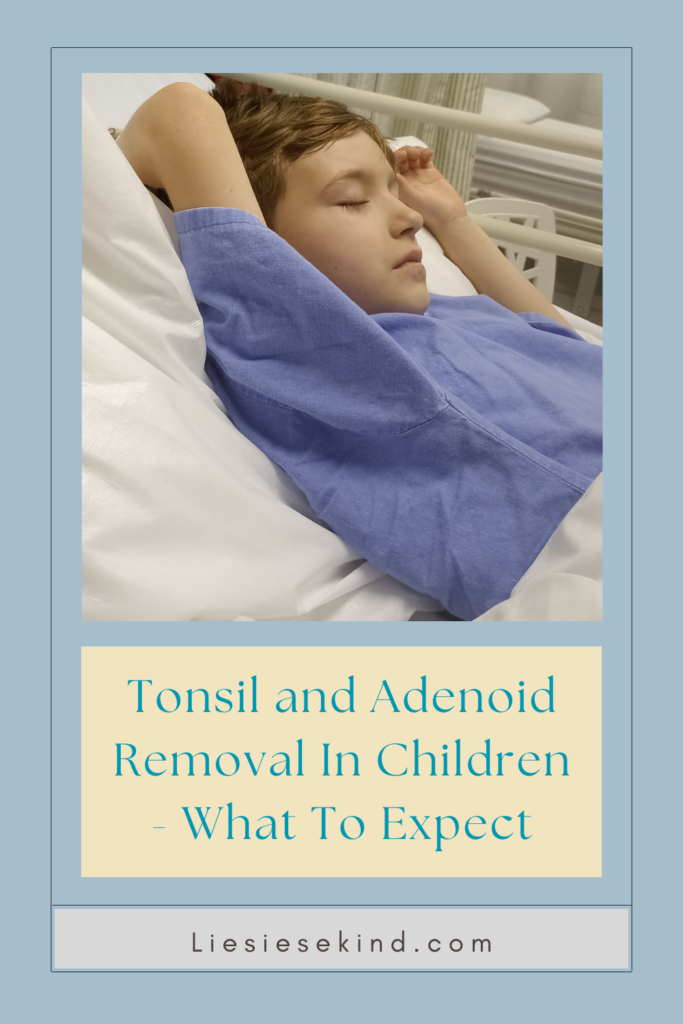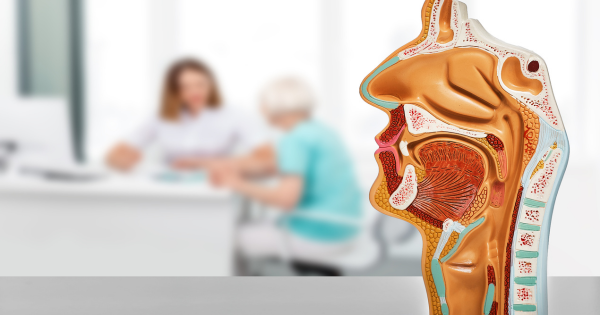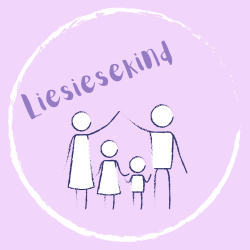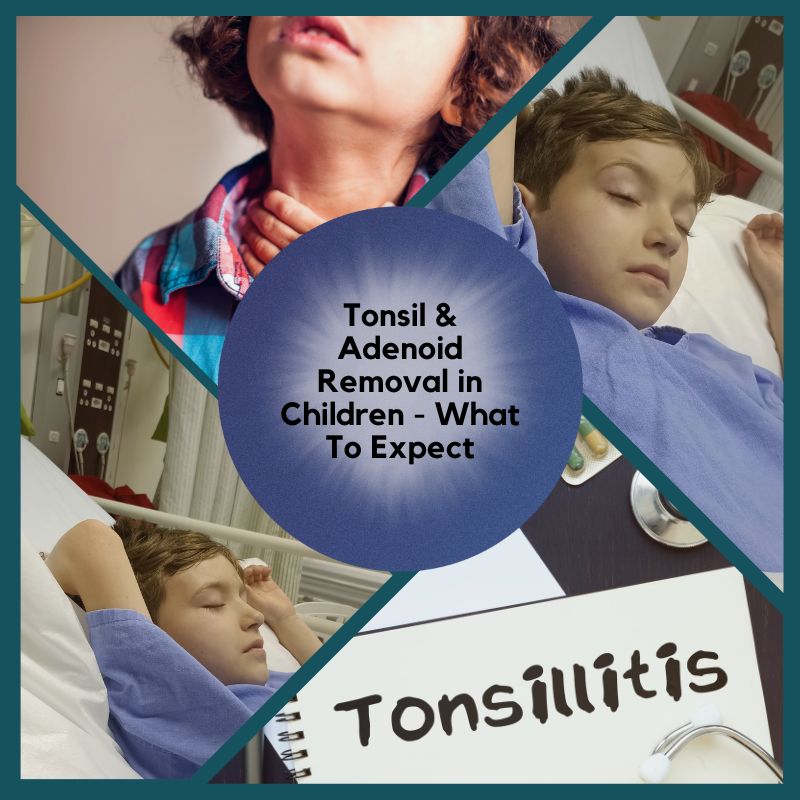Today’s post is a helpful guide to tonsil and adenoid removal in kids – what you can expect. My son JD has had ongoing issues with strep throat, sinusitis, etc. We had him at our house doctor twice during the recent school holidays, where he had to take antibiotics. During the first visit, the doctor mentioned that he was worried about his tonsils because they were swollen and red. With the second visit, the tonsils looked even worse, so he referred us to an ear, nose, and throat specialist to decide whether his tonsils needed removal.
The specialist scheduled a tonsillectomy and adenoidectomy. Turns out my son’s hearing in the one ear was not as good as the other ear because of his adenoids and tonsils. Tonsillitis is common in children where the tonsils, the two masses of tissue at the back of the throat, become inflamed and swollen. It can be caused by viruses or bacteria. Here’s some information about tonsillitis in children:
What Are The Causes of Tonsillitis in Children
- Viral Infections: The most common cause of tonsillitis in children is viral infections, particularly the ones responsible for colds and flu. These include the adenovirus, rhinovirus, and influenza virus.
- Bacterial Infections: Streptococcus pyogenes, also known as Group A Streptococcus, is a common bacterium that can cause bacterial tonsillitis, known as strep throat. This type of tonsillitis requires medical attention as it can lead to complications if left untreated.
What Are The Symptoms?
- Sore throat
- Difficulty or pain when swallowing
- Swollen and red tonsils
- White or yellow patches on the tonsils
- Fever
- Headache
- Stomach ache
- Bad breath
- Fatigue

Treatment For Tonsillitis:
- Viral Tonsillitis: Since most cases of tonsillitis are viral, treatment usually focuses on relieving symptoms. This includes rest, staying hydrated, using over-the-counter pain relievers (under a doctor’s guidance), and consuming soothing foods like warm soup and cool liquids.
- Bacterial Tonsillitis (Strep Throat): Antibiotics are usually prescribed if the tonsillitis is caused by a bacterial infection, particularly strep throat. It’s essential to complete the full course of antibiotics even if symptoms improve to prevent complications such as rheumatic fever.
When Should You Seek Medical Attention?
- If your child has difficulty breathing due to swollen tonsils.
- If your child has severe pain not relieved by over-the-counter pain medications.
- If your child has a persistent high fever.
- If your child has trouble swallowing and is unable to drink fluids.
- If symptoms worsen or do not improve after a few days.
Preventing Tonsillitis:
- Encourage good hand hygiene to prevent the spread of infections.
- Teach children to cover their mouths and noses when coughing or sneezing.
- Avoid close contact with individuals who have a sore throat or respiratory infections.
In cases of recurrent or chronic tonsillitis, where the child experiences frequent episodes of tonsillitis that significantly impact their quality of life or health, a doctor might consider a tonsillectomy, which is the surgical removal of the tonsils. It’s vital to consult a healthcare professional for an accurate diagnosis and appropriate treatment if your child is experiencing symptoms of tonsillitis.
- This information is provided for general awareness and should not replace medical advice from a qualified healthcare provider.

Tonsil and Adenoid Removal in Kids – What To Expect
Tonsillectomy and adenoidectomy are surgical procedures that involve the removal of the tonsils and adenoids, respectively. These procedures are commonly performed in children to address issues such as chronic infections, obstructive sleep apnea, and other related problems. Here’s what you can generally expect before, during, and after these surgeries:
Related: 8 Must-Have Items To Keep In Your Baby’s Medicine Cabinet
What To Expect Before the Surgery:
- Consultation: Your child’s doctor will assess their medical history, symptoms and may order tests to determine if the surgery is necessary. They will also provide instructions on pre-operative preparations.
- Fasting: Your child will typically need to fast for a specific period before the surgery. This ensures an empty stomach and reduces the risk of aspiration during anesthesia.
- Medical Evaluation: Your child may undergo a medical evaluation, including blood tests, to ensure they are healthy for the surgery.
- Anesthesia: Tonsillectomy and adenoidectomy are usually performed under general anesthesia, meaning your child will be asleep during the procedure.
What To Expect During the Surgery:
- Tonsillectomy: The surgeon removes the tonsils from the back of the throat. This is usually done using surgical instruments or, in some cases, with advanced techniques such as laser technology.
- Adenoidectomy: The surgeon removes the adenoids located at the back of the nasal passage. This is typically done through the mouth, so no external incisions exist.
What To Expect After the Surgery:
- Recovery Room: After the surgery, your child will be taken to a recovery room, where medical staff will monitor them until they wake up from anesthesia.
- Pain Management: Tonsillectomy and adenoidectomy can cause throat pain and discomfort. Pain relief will be provided, which may include pain medications and throat-numbing sprays. In our case, the doctor prescribed Stilpane four times daily and Empaped suppositories every eight hours if needed.
- Diet: Your child will start with clear liquids and gradually progress to a soft diet as tolerated. Avoid giving them very hot, spicy, or acidic foods, as these can irritate the healing area.
- Hospital Stay: Tonsillectomy and adenoidectomy are often performed as outpatient procedures, meaning your child can go home on the same day. In some cases, an overnight stay might be required for observation. JD was discharged the same day after he had eaten a sandwich and drank some Coke.
- Recovery at Home: Recovery time varies, but it generally takes 1 to 2 weeks for the throat to heal. During this time, your child should rest and avoid strenuous activities. Follow your doctor’s instructions for care.
- Follow-up: Your child will have a follow-up appointment with the doctor to ensure that healing progresses and to address any concerns. JD’s throat felt much better after two weeks, and he started eating hard foods again. However, another issue was keeping me up at night with him. Since his surgery, he suffered extreme headaches, mild ear pain, and throat aches. The throat pain improved, but the headaches didn’t. So, with his follow-up visit to the specialist, the doctor prescribed meds for pain and inflammation, probiotics, and antibiotics. The headaches disappeared on the first day of taking these meds, and he was ready to return to school.

Potential Side Effects and Complications:
- Pain and Discomfort: Throat pain is expected after the surgery, and pain medications can help manage this discomfort.
- Bleeding: Although rare, there is a risk of postoperative bleeding. Contact your doctor if you notice persistent bleeding.
- Change in Voice: Temporary changes in voice quality might occur due to swelling around the surgical area.
- Bad Breath: Foul breath might be present during the healing process. This is normal and should improve as the area heals. JD’s bad breath went away after the first week.
- Infection: While infection is rare, it’s essential to watch for signs of fever, increasing pain, or worsening symptoms.
It’s crucial to closely follow your doctor’s instructions regarding post-operative care, diet, and activity restrictions. Every child’s experience is unique, so consult your healthcare provider for personalized guidance and information about your child’s situation.
Tips on How To Help Your Child After Tonsil and Adenoid Removal
Helping your child recover after a tonsillectomy and adenoidectomy can make the healing process smoother and more comfortable. Here are some tips to assist your child during their recovery:
Pain Management:
- Administer pain medications as prescribed by the doctor to manage pain and discomfort.
- Use a timer to track when your child needs their next dose of pain medication.
- Over-the-counter pain relievers may be recommended, but always consult your doctor before giving any medication.
Hydration:
- Encourage your child to drink plenty of fluids to prevent dehydration and soothe the throat. Our house doctor told us that drinking and even gargling with coke really helps speed up the healing process.
- Offer cool and soothing beverages like water, clear soups, ice chips, and popsicles. If your child has headaches like JD, you can place a cool washcloth on his forehead to offer relief.
Soft Diet:
- Stick to a soft diet for the first few days to avoid irritating the surgical area. These can include jelly with custard, yogurt, ice cream, soup, etc.
- Offer foods that are easy to swallow and won’t cause discomfort, such as yogurt, applesauce, mashed potatoes, and oatmeal.
Avoid Irritating Foods:
- Avoid acidic, spicy, and crunchy foods that can cause irritation or discomfort to the healing area. The specialist said that JD should not only eat soft foods but also hard foods like biltong, toast, etc., to speed up the healing process. However, during the first few days following surgery, it was just too painful to swallow, so we stuck to a soft diet for the first 4-5 days, and then we tried hard foods again.
- Steer clear of citrus fruits, tomato-based foods, and anything with sharp edges.

Rest and Sleep:
- Ensure your child gets plenty of rest and sleep to aid in the healing process. During the first three days after surgery, JD slept a lot, and it really helped his body to start healing.
- Elevating the head slightly while sleeping might help with breathing and reduce discomfort.
Humidifier:
- Use a humidifier in your child’s room to keep the air moist, which can help alleviate throat dryness and discomfort.
Cool Mist Vaporizer:
- A cool mist vaporizer can add moisture to the air and help ease breathing.
Throat Care:
- Encourage your child to sip warm liquids or suck on throat lozenges if allowed by the doctor.
- Avoid coughing or clearing the throat forcefully, as this can strain the healing area.
Entertainment and Distraction:
- Provide your child with activities, books, movies, or games to keep them entertained and distracted during their recovery.
Gentle Oral Care:
- Maintain gentle oral hygiene by encouraging your child to brush their teeth carefully and avoid vigorous rinsing.
Comfort Measures:
- Offer comfort items such as soft pillows, cozy blankets, and their favorite stuffed animals to create a soothing environment.
Avoid Contact with Sick Individuals:
- Keep your child away from individuals who have contagious illnesses to prevent the risk of infection during the vulnerable recovery period.
Follow the Doctor’s Instructions:
- Adhere to all post-operative instructions provided by the surgeon or medical team.
- Attend all follow-up appointments as scheduled.
Monitor for Complications:
- Keep an eye out for signs of infection, bleeding, or any worsening symptoms, and contact your doctor if you’re concerned.
Final Thoughts
Remember that each child’s recovery is unique, and their needs may vary. Providing comfort, support, and following medical guidance will contribute to a smoother recovery process. If you have any concerns or questions, don’t hesitate to contact your child’s healthcare provider. I must say, these past few weeks were very stressful and challenging, especially since I didn’t have my tonsils removed as a kid and subsequently got tonsillitis myself. It wasn’t easy making JD comfortable and caring for his needs while I was also very sick. But we got through it, and both JD and I are healed and ready to resume our everyday activities.
I hope this guide about what to expect after tonsil and adenoid removal in kids has been useful and that you will follow these guidelines to make the healing process a lot easier on your child … and you.





Be the first to reply